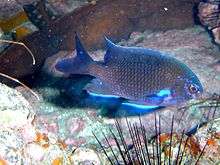Canary damsel
| Similiparma lurida | |
|---|---|
 | |
| Not evaluated (IUCN 3.1) | |
| Scientific classification | |
| Kingdom: | Animalia |
| Phylum: | Chordata |
| Class: | Actinopterygii |
| Order: | Perciformes |
| Family: | Pomacentridae |
| Genus: | Similiparma |
| Species: | S. lurida |
| Binomial name | |
| Similiparma lurida (Cuvier, 1830) | |
| Synonyms | |
|
Abudefduf luridus Cuvier, 1830 | |
Similiparma lurida also known as the Canary damsel is a species of marine fish of the family Pomacentridae.[1] It is found in the eastern Atlantic Ocean, specifically near Madeira, the Azores, Canary Islands, Cape Verde and Senegal.[2]
S. lurida is commonly associated with reefs in subtroipcal regions, where individuals grow to around 15 cm in length, and feed primarily on algae and small invertebrates.[2][3]
Canary damsels inhabit rocky areas, where they lay eggs that are defended by males. The young are can be found along the coast, especially in tide pools[4]
Each fish has large eyes, with coloring that is black to brownish black with blue on the fins, and lighter colors on the ventral part of the body. Juveniles may have lateral stripes on their bodies as well. During their mating season, adults exhibit sexual dimorphism.[2]
References
- ↑ Cooper, W.J., Albertson, R.C., Jacob, R.E. & Westneat, M.W. (2014): Re-description and Reassignment of the Damselfish Abudefduf luridus (Cuvier, 1830) Using Both Traditional and Geometric Morphometric Approaches. Copeia, 2014 (3): 473–480.
- 1 2 3 Froese, Rainer and Pauly, Daniel, eds. (2015). "Abudefduf luridus" in FishBase. February 2015 version.
- ↑ Reiner, F. (1996): Catálogo dos peixes do Arquipélago de Cabo Verde. Publicações avulsas do IPIMAR No. 2. 339 p.
- ↑ Quignard, J.-P. & Pras, A. (1986): Pomacentridae. p. 916-918. In P.J.P. Whitehead, M.-L., Bauchot, J.-C., Hureau, J.N. & Tortonese, E. (eds.) Fishes of the north-eastern Atlantic and the Mediterranean. UNESCO, Paris. Vol. 2.